Duel Kawasaki Z1000SX 2017 Vs Yamaha Tracer 900: all-in-one
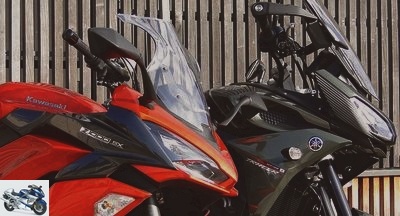
The Kawasaki Z1000SX is an excellent sport-GT motorcycle, made even more versatile in 2017 with interesting evolutions. But are its advanced electronics and reworked comfort enough against the very complete Yamaha Tracer 900 and its salivating performance / price ratio? ? MNC duel to Euro4 standards.
Page 2 – Dynamics: a very close match !
The first turns of the wheel with these two hyper-versatile semi-faired roadsters are done in one: the thermometers of the Z1000SX and the Tracer 900 drop to -5 ° C and the gusts of wind reinforce the feeling of cold even more. .. It stings, especially in the absence of standard heated grips. And global warming, then ?!
The best protection of the Yamaha and its hand guards are heartwarming in these conditions, and the rest too! If the aspect "Goldorak" of its handguards divides – just like the general silhouette of the motorcycle – their approval rallies all the votes. In town, however, be careful to integrate their large size … Still, the bust, shoulders and a large part of the helmet are properly sheltered behind its bubble, surprisingly effective in view of its format.
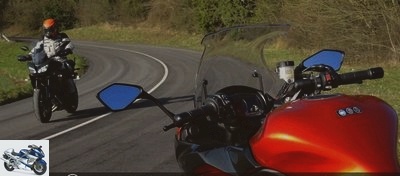
Satisfaction is far from similar on the Z1000SX, still fairly average on this point despite the new design of its screen and its additional millimeters. Kawasaki’s stubbornness in keeping a tilting windshield too short pays off here painfully because of the cold! Of course, going from high to low is easier thanks to this system. And the screen thus retains a sporty aspect that is much more sexy than the "pie server" look of the Tracer 900..
But the deflection suffers, with noticeable eddies on the top of the bust and the entire upper half of the helmet. Same insufficiency at the shoulders, copiously "ventilated". We console ourselves – a little – with the best protection of the lower limbs provided by its elegant fairings, especially at the level of the shins. The Tracer 900 does less well, but only slightly because the narrowness of its 18 l tank allows excellent leg integration..
Thanks to this successful design and its general compactness, the knees and thighs are more "body" on the Yamaha. This feature enhances the deflection generated by its short fairings, in addition to improving support in the saddle. Very wide on its upper part, the 19 l can of the Z1000SX clearly sets the knees apart. The Kawasaki, however, provides better accessibility thanks to its lower seat height (not adjustable to 815 mm, against 845 mm on the Tracer in the low position).
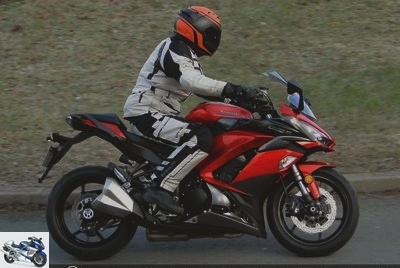
In general, the more generous volumes of the Z1000SX betray its 196cc and its additional cylinder (4-in-line Vs 3-in-line). To this difference in architecture is also added a difference in mechanical generation, since the Yamaha "CP3" benefits from a very recent design, so the origins of the 4-legged go back to the late ZX-9R, boosted with recent parts. ZX-10R.
All this explains the considerable difference in weight between the two motorcycles: 235 kg against 210 kg fully loaded. Another notable difference is the sport-GT ergonomics of the "Zed" SX. Pleasant at medium and high speed, it generates its share of downforce at low speed, despite an inclination of the bust and a retreat of the footrests finely calculated to avoid excess. Far from being as demanding as on a sports car, this position is halfway between roadster and road. That is exactly the credo of the Z1000SX !
On the Yamaha, the bust is straight and the arms are stretched around the very wide handlebars (910 mm measured Vs 780 on the SX!), A position evoking the trail type with which the Tracer 900 flirts. This relaxed ergonomics associated with its featherweight make the Yam ‘literally twirl in traffic jams and virolos, impeccably served by agile and frank management. The bike is lively without being vicious: a very pleasant compromise, conducive to improvisation and playful driving !
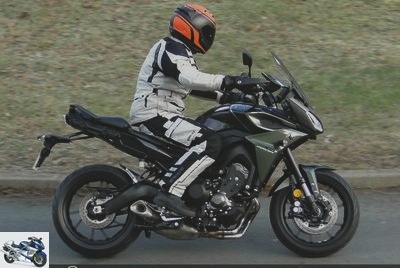
Because of its ergonomics and its additional 25 kg, the Kawasaki requires more seriousness and energy. Especially since it is also necessary to deal with its front axle falling below 30 km / h, a phenomenon attributable to its masses more carried on the front but also to its rear tire with Superbike dimensions: 190/50/17 against 180/55 / 17 on the Tracer 900. More chic, but also more expensive to replace …
Penalizing in tight curves, this tendency to engage dessert also at low speed and engine off. When turning around in 5.48m (measured) is childishly simple on the Yamaha, doing the same on the Kawasaki in 5.80m requires extra "maturity". And muscles too, compared to its relative overweight !
Exceptional engines
This is the main advantage of the Z1000SX and the Tracer 900: their powerful and sensational engine, perfectly suited to the Sport-touring program. Flexible, Akashi’s 4-cylinder and Iwata’s 3-legged have an availability worthy of a Swiss banker in the face of a French budget minister. Both agree to evolve in slow motion on the last report, without weakness or hiccups.
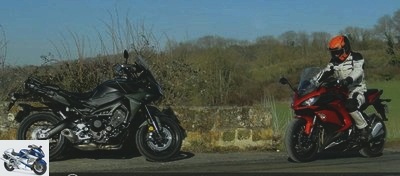
The block taken from the Z1000, however, leads the operation with greater approval than that taken from the MT-09. And above all, these revivals at very low revs have more force: the Kawasaki resumes smoothly from 1250 rpm to 30 km / h in 6th gear, when the Yamaha requires 1750 rpm, or 40 km / h. In this, the Z1000SX evokes the old generations of "4-legs", hyper full and consistent but with more inertia than modern engines..
At 90 km / h in sixth, the moderately visible increments of the Tracer 900 stabilize at 3500 rpm, while the Kawasaki needle clearly indicates 3750 rpm. Unfortunately, this is exactly the speed at which the 4-cylinder starts to vibrate, despite the installation of a balance shaft for 2017 … The Yamaha, on the other hand, is free from annoying vibrations.
The characteristic crackles of the Z1000SX, although less pronounced than before, are still – too – present. Especially since they intervene from mid-revs, so in the operating range in solo and especially in duo. The Green catches up with a clutch lever – adjustable – exquisitely soft, while that of the Tracer 900 is firmer. Too bad also that it is not adjustable in spacing because it is a bit distant…
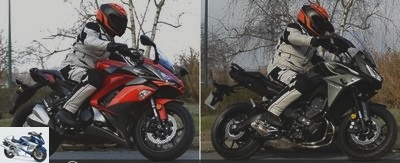
The Kawasaki is also taking the lead in terms of primary drivetrain thanks to its quick and quiet selection. Identical to that of the MT-09, the selection of the Tracer 900 offers the same operation, a little rough. However, the "Zed SX" loses a few points in terms of its final transmission, not completely transparent despite the chain. The Yamaha does better in this area. Both offer a precise and pleasant injection except in A mode on the Tracer 900, quite brutal.
It should be noted once again that the mapping developed specifically for the Tracer 900 gives it an approval and a progressiveness which are somewhat lacking in the roadster from which it derives. MNC would have nothing against finding this mapping on the MT-09, which can always be improved on this point even in its latest version! To good hearers, on the side of Iwata !
Equality of good points !
At this point, the distribution of good points rewarding their dynamic abilities borders on the equality between the Tracer 900 and the Z1000SX. This is when the Green sheds its best cards: on the one hand, the exceptional breath of its engine, superior to that of Iwata. The "CP3" may have a lot less kilos to tow, nothing helps: if the Tracer 900 and the Z1000SX are on an equal footing up to 3000 rpm, the "Zed" then accelerates much harder.
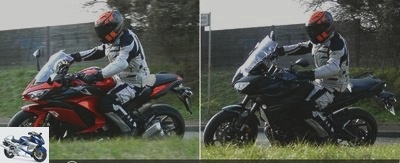
Carried by its very expressive hoarse sound, Akashi’s engine confirms its advantage in the towers, with its displacement and its additional 27 hp (142 hp against 115). Still, the revivals of the Tracer 900 are strikingly vital, especially at mid-revs. And its cavernous soundtrack combined with its responsiveness multiply the sensations! But his thrust settles down in the last graduations of the tachometer, when that of his rival is still muscle there.
"Zeu", "Zet" and a match on a mechanical level for the Z1000SX which reinforces its reputation as a motorbike with multiple facets, capable of alternating soft caresses and torrid nags with a confusing naturalness! Lovers of high-performance 4-cylinders and purveyors of sensations, it’s always at Kawa ‘that it’s happening !
Brilliant when accelerating, the Zak ‘is also brilliant when braking: biting but dosable, its monobloc calipers are the "brakes", precisely, to the Yamaha radial device. If its power is on par with the Z1000SX, the right lever of the Tracer 900 lacks consistency on its first third. Progressiveness and precision suffer, especially at high pace, as on the MT-09.
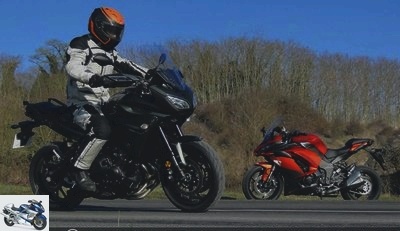
The Z1000SX continues its convincing demonstration with a quality of suspension a notch above, especially at the level of its inverted fork. Well held in hydraulics, this offers a successful combination of shock absorption and support, even on hard braking. Under these conditions, the Tracer 900 fork tends to sag on its large travel..
Same observation at the rear: the Yamaha is not as rigorous at high pace, letting out slight movements caused by transfers of trim not always controlled. On the contrary, the Kawasaki offers royal stability, capable of playing with curves at Mach 12. The downside: its damping lacks a touch of sensitivity at the start of the race, causing drier reactions in the races. dented parts.
Less rigorous, of course, the Tracer 900 takes advantage of its relative flexibility of suspensions to better digest the obstacle. When the Z1000SX starts to jerk, the Tracer 900 goes through bumps without slowing down, while still giving the rider better handling. And since the Kawasaki saddle is ultimately no more comfortable over the long haul than that of the Yamaha – yet firmer at first glance – the Tracer 900 wins the mixed course bet..
Verdict: the Greens on the right track (r)
In MNC’s memory, rarely has a duel been so close between two motorcycles: the Tracer 900 as the Z1000SX are both kneaded with qualities, starting with a sensational engine, in the true sense of the term. It is even more difficult to decide between them, as this factor turns out to be subjective: some will be sensitive to the extra pep of the 4-legged while others will swear by the roundness packed with punch of the 3-cylinder..
In both cases, the large difference between the trunk at the bottom and the temperament in the towers is simply incredible, with a fairly clear performance advantage for the Z1000SX. What a success this block of "Zed", even though its 196cc and its 27 additional ones favor it "mechanically"! Too bad its vibrations spoil the pleasure, especially in contact with its reservoir with a perfectible design (too big on its upper part) …

The Z1000 in road dress also benefits from better braking and superior quality suspensions, which however remain a little dry on the bumpy. Barely slower on billiards, the streamlined MT-09 tolerates the vagaries of asphalt better. And in the winding, its record agility works wonders: its setting on the incisive angle sometimes gives the impression of being at the controls of a supermotard supercharged, a sensation reinforced by its very wide handlebars. !
But above all, as described in, the Tracer 900 scores capital points thanks to its irreproachable standard endowment with regard to its price. Deprived of many of its very practical equipment (compare on page 3), the Z1000SX is a pale figure, especially when we include its additional € 3,100 in the equation … Too much wanting to compare to so-called "Premium" motorcycles (BMW R1200RS ), Kawasaki forgets the essentials like a 12V plug, a central stand and a "real" bubble! Yamaha does not make this mistake.

The sophisticated electronics of the Z1000SX are not enough, either, to justify such a price difference: certainly its IMU (inertia unit) increases the responsiveness and finesse of the ABS and traction control, which are more transparent. than Yamaha devices. But this parameter is almost imperceptible: it is when they are pushed like sports motorcycles that differences appear, with in particular a more castrating regulation on the Tracer 900 in the event of loss of traction..
Not enough to reverse the outcome of this match clearly in favor of this insolent Tracer 900, with its relevant compromise between dynamism and versatility. We understand better why it sells like hot cakes … and we dream of a Tracer 900 "R" mounted in Ohlins (historical suspension partner of Yamaha), even more rigorous and comfortable !
Related articles
-
Duel Kawasaki Z1000SX 2017 Vs Yamaha Tracer 900: all-in-one The Kawasaki Z1000SX is an excellent sport-GT motorcycle, made even more versatile in 2017…
-
Duel Yamaha Niken GT Vs Tracer 900 GT: the good three (wheels) plan ? A motorcycle is two wheels, a handlebar and a motor. The proof, we have always done…
-
Duel Kawasaki Z650 Vs Yamaha MT-07: bestseller fight ! Exceeded by the MT-07 both dynamically and commercially, the appreciated ER-6n is transformed into…
-
2017 Yamaha MT-09 review: mult (r) iples pleasures ! Having become a bestseller in just four years, the Yamaha MT-09 is full of positive developments for…
-
Duel F750 GS Vs Tracer 700: small trails, large road bikes ? New distinct look, improved practical aspects, two-cylinder 689 cc to Euro5 standards: the…
-
Duel Z900 Vs Street Triple S: one fight, two bosses Displayed at 8,900 euros, the Z900 and the Street Triple S use very different arguments to appease…
-
Test Yamaha Tracer 900 and Tracer 900 GT 2018: the way of wisdom Unclassifiable, the Yamaha Tracer 900? This sporty road bike derived from the stormy…
-
Duel Triumph Street Triple R Vs Yamaha MT-09 SP 2018: triple muse ! Will the new suspensions of the Yamaha MT-09 SP give it the rigor it needs to keep…
-
Duel Yamaha MT-10 SP Vs Kawasaki Z1000R: monstrous ! Sharpened by high-end peripherals , the Kawasaki Z1000R and Yamaha MT-10 SP embody the quintessence…
-
Duel Tracer 900 GT Vs V-Strom 1000 Adventure: services included Yamaha strikes a blow (t) with its Tracer 900 GT 2018 and its ultra complete standard…